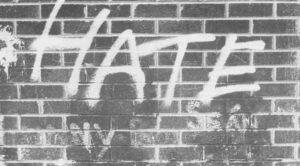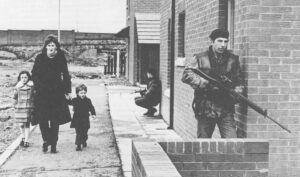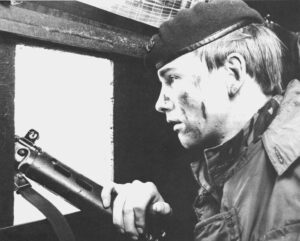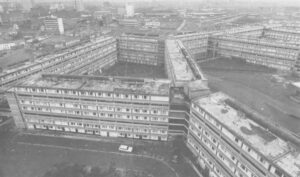(BELFAST) – Cupar Street is a no man’s land. An administrator in the Department of the Environment recently referred to it as “the frontier,” as if it were a stretch of wilderness between two nations across which there were daring escapes. Other bureaucrats call it an “interface”. In fact it is just a street. The neighborhood to the south of it is a densely packed, working class Catholic district full of two-story brick houses built in the last century for linen mill workers. The neighborhood north of the street is not so dense and is populated by Protestants. Between the communities is a wall, commonly known as the peace line.
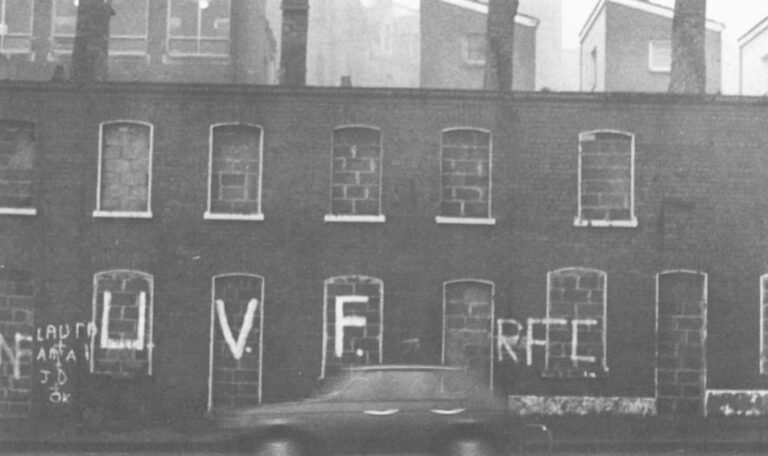
The wall is made up of rows of derelict houses, all but three of them bricked shut, and sections of corrugated iron, 20 feet high, which stretch across avenues that once intersected Cupar Street. At the far end of the border, where Cupar Street curves into Catholic territory, the army has installed an iron gate that resembles the drop arm barriers at railroad crossings. The gate is chained shut, preventing car traffic between the two communities. Pedestrians, however, can cross at all times, and they do. Protestant workers employed at factories on the Catholic side of the line cross over at the iron gate every day, and no one pays them much attention. Some Catholic women will cross to the Protestant side to do their shopping, but they are considered bold to do so by many of their neighbors.
In 1969, all of the houses on Cupar were occupied, and the street was “mixed” – Protestants and Catholics lived together. There was much traffic between the two communities. Protestant women used the laundromat on Clonard Gardens, their husbands patronized the bookie on Kashmir Road; both establishments were on the Catholic side of Cupar. Catholic women did their shopping on the Protestant Shankhill Road. Pubs, usually owned by Catholics, catered to both tribes. Peace and calm prevailed.
In Belfast, however, peace and calm is always punctuated by rioting. There were clashes in 1835, 1843, 1857, 1864, 1872, 1880, 1884, 1886, 1898, 1920-22, 1935, and 1964, and the Cupar Street area figured in the last five of those uprisings. Today’s peace line is on the site of the 1886 riots.
The corrugated iron sections of the wall, which formally ended traffic between the two camps, were put up by the army after the night of burning and shooting in the Cupar Street area on August 15, 1969. In its report, “Violence and Civil Disturbances in Northern Ireland in 1969,” the Scarman Commission, appointed by Parliament, summarized the August 15th riots, and found that both sides of Cupar suffered casualties in roughly equal number; there was one fatality on the Catholic side, a boy, 15 years old, named Gerard McAuley, who was killed by a Protestant gunman. The brunt of the property damage, the tribunal reported, was borne by Catholics, particularly the ones who lived on Bombay Street, where three-fifths of the houses were destroyed by fire. Apart from a few homes in Cupar Street which required minor repairs, hardly any Protestant homes were damaged.
“The Protestants began the fighting and were responsible for most of the destruction,” the Commission reported on the Cupar Street area. “It is likely that they were retaliating against what they believed was Catholic aggression in neighboring areas on the previous two nights…. No police reached the area until after 9:30 p.m. and then only a token force…. It is not suprising that many Catholics feel that they had been deserted by the police.”
After that night, homemade barricades were constructed on both sides of Cupar Street to keep out invaders. When the army put up the corrugated iron sheeting shortly thereafter, it was merely a formalization of what was already there.
About four years ago, Richmond Stokes, an architect, and David Thompson, an official of the Northern Ireland Housing Executive (the public housing authority), began work on a $3 million redevelopment project on the Protestant side of the peace line, a project which has rehabilitated many of the old houses. Both Stokes and Thompson are quite popular in the area, and their project has generally breathed new life into a dead neighborhood.
Stokes was troubled by the derelict houses that form the peace line. He felt they were an anchor dragging the whole neighborhood down, and he would have renovated them but for the fact that it would serve no purpose. No one would move into them, as no one wants to live on a battlefield, no matter how plush the accommodations. So the architect proposed that the houses be torn down, that the strip be landscaped and left open as a green area which would act as a buffer between the two communities.
The Protestant community rejected the idea, arguing that a green would give the two sides a clear shot at each other and would just become a stone throwing arena. Stokes also discovered that removing the derelict shells would only change the location of his dilemma: instead of having shells on Cupar, he would then have shells on the street behind Cupar, as no one wanted to live in the last houses on the frontier. Stokes would have to write off the $90,000 he had just spent rehabilitating houses on the next street, as the houses would just stay vacant.
The community proposed that, instead of tearing down the Cupar Street shells, Stokes replace them with a permanent wall. The architect went back to the drawing board and came up with a design for a six foot structure. The community told him it wasn’t high enough. The police, estimating the range of the local stone throwers, asked for something closer to 20 feet high. And so Stokes came up with a plan for a 20 foot wall with a four foot fence on the top.
According to David Thompson, who worked alongside Stokes at that point, the wall was to be 16 inches wide at the bottom to withstand the burrowing attempts of local hooligans. It was to be made of Tyrone brick, which would blend with other buildings in the district. Behind the wall on the Protestant side, where the derelict buildings are now, there would be a landscaped area with trees and thorny shrubs. Thorny shrubs were chosen for their longevity, as it is difficult for vandals to pull them up.
The design met with approval in the Protestant community, and it was then shown to a group from the Catholic side of the line. They too were well pleased.
“It is a serious plan,” Stokes says, “but everyone is holding off because no one wants to build it. The cost of the construction of a brick wall, coupled with the feeling that you’d be dividing the city off with a Berlin-type wall, is just too much for people to take.”
An alternative to Stokes’ design appeared recently, but only briefly. The Department of the Environment proposed widening Cupar, cutting off the intersections, making it a boulevard to connect two other thoroughfares. However, the two communities didn’t think a roadway would provide enough protection, and asked for a wall anyway. Now with massive government cutbacks on public expenditure, Stokes says the road plan “has gone out the window.”
Someone, however, will have to act in the not too distant future. The derelict shells, Stokes says, are in such a state of disrepair they they will collapse of their own accord in 12 to 18 months.
Richard and Agnes McCrea, a couple in their 40s, have lived on Sugarville Street, on the Protestant side of the peace line, for 19 years. Rich works as a cleaner at City Hall, and some of his co-workers are Catholics. He says they go out for a drink after work sometimes, but always in the city center, which is neutral territory, and never in their respective neighborhoods. Agnes describes herself as a God-fearing person, walks through Catholic neighborhoods on her way to work every morning, and talks with great animation of how peaceful life was before the troubles started. “When you went to the pictures, people knew where you came from, and nobody cared,” she says. “It was like anywhere else in the world where Protestants and Catholics go to the same picture house and nobody cares what anybody is.”
The McCreas have seen considerable trouble in the past decade, and they remember well the night it all started. Agnes thinks a lot of Catholics burned their own homes on the night of August 15, 1969. “It was a question of burn it yourself before you let someone else burn it. We were saying, ‘Shame, shame’, thinking that the Protestants had set it [Bombay Street] on fire, but then we heard that the IRA had done it.”
In the months and years that followed the burning of Bombay Street, the McCreas’ neighborhood emptied. People left not only Cupar Street, but the surrounding streets as well, as they were just plain scared. The buildings were bricked shut, and the neighborhood became an eyesore. “There were 25 houses empty on this street,” Rich says. “From two doors down to the end of the street was all blocked up.”
The McCreas gave serious thought to leaving, but now, with the redevelopment program reviving the district, they are glad that they stayed. The neighborhood is not without its problems, however. Shops on the Shankhill pay protection money to Protestant paramilitary groups. With the old neighbors gone and new ones moving in, no one knows who anyone is anymore. “People are afraid to speak to their own kind,” Rich says. “You’re afraid to speak your mind because someone will come down and break your window or give you a hammerin’…. And there’s very little work for young lads here at the present time, and they’ll do anything to get money. They’ll thump me, they’ll thump anyone. They don’t care what you are, Protestant or Catholic.”
“I think they have seen so much trouble that robbing a shop is nothing,” says Agnes. “Breaking into a shop is nothing when so many people have lost their lives.”
The younger children from both sides of the peace line throw stones at each other, for the most part just on warm summer nights. Many houses within a stone’s throw of Cupar Street have metal screens over their windows to ward off missiles. The screens are provided free by the housing authority or the Department of the Environment after the windows are broken for the second or third time.
The McCreas claim these stone throwing sessions are only vicious on the surface. “The hooligans from the two sides have gotten to know each other,” Rich says. “They call each other by their names, they say ‘See you tomorrow night’. I haven’t seen anybody get hurt yet throwing stones at each other.”
“It’s a crowd of bad lads just out for badness,” says Agnes.
The stone throwers and hooligan raids into enemy turf to paint slogans and vandalize each other’s neighborhoods have provided some of the impetus for meetings between the two communities. The meetings, organized by a Catholic priest and a Protestant minister, are attended by a handful of people from both sides, and sometimes a civil servant or a representative of the police or army has been invited to discuss specific problems. The Catholic city councilman has come, but the Protestant counselor has stayed away, reportedly for fear that his constituency might not appreciate their representative fraternizing with a Catholic clergyman. The McCreas have attended the meetings, but they don’t broadcast the fact in their neighborhhod because it might be misconstrued.
Theresa Quigley also attends the meetings, which is extraordinary, given that she was one of the Catholics burned out in the Bombay Street conflagration. After the holocaust, the refugees were housed with relatives and in mobile homes, and representatives of the Catholic community solicited donations in the United States and the Republic of Ireland to build new homes for the victims. Mrs. Quigley lives in one of those new homes on Bombay Street. A plaque on the wall in the middle of her row of houses commemorates Gerard McAuley, the 15 year old boy “who died defending the people of Bombay Street on August 15, 1969.”
The new houses back up and rest flat against the Cupar Street peace line, and their rear windows are covered with protective screens. Mrs. Quigley is the second tenant to live in the house; the first was an elderly couple who moved because they couldn’t stand the pressure of the location – the man began to imagine that he could hear people from the other side digging tunnels underneath his house. Mrs. Quigley was reluctant to move in, and her attitude toward the location seems to alternate between defiance and fear. She thinks it is important that Republicans make a stand, and regrets that she and most other people evacuated the area on the night Bombay Street was burned. “I think if we had stayed we might have been able to save some of the burning houses ourselves,” she says. At the same time, however, Mrs. Quigley has a prescription for Valium, which is not at all uncommon for the men and women of that area.
It is not simply the threat implied by the corrugated wall and the bullet holes in Mrs. Quigley’s back wall that makes so many people in the area nervous. The Quigleys and their neighbors are plagued by teenage hooligans, seemingly fearless, who prey on their own kind. Nearly every house has been broken into at least once, the shops countless times, and one Post Office has been robbed on more than 20 occasions. The area is much more dense than the neighborhood on the Protestant side; Catholics have fewer alternatives in housing, and can’t afford the luxury of abandoning homes on the peace line. There are rumors of corruption in housing allocation, of houses arranged for people with the right political connections or with enough money to pay “key money” to a local offical. The police are feared and often hated; one local woman, a provisional IRA sympathizer who also was displaced by the Bombay Street fire, claims “If the army leaves, I do too,” meaning that she does not want to be left at the mercy of the overwhelmingly Protestant police force, whose protection she finds suspect.
Mrs. Quigley works as a waitress at a hotel deep in Protestant territory on the other side of the city. She gets along well with her co-workers, many of whom are Protestant, so there would seem to be no bigotry coloring her firm opinion that a wall between the two communities is absolutely necessary. Both sides, she says, need to be protected from the other’s hoods. She also thinks Catholics need protection from Protestant terrorists, who in the last two years have killed at least three men in sorties into the neighborhood. In this district, three men dead are not just three fatalities, they are Bridget Kearns’ son, the McParland boy, and the old man in Clonard Gardens.
If there was no peace line, would there be more stone throwing? Or would the pattern of targets simply shift, as hooligans tried to strike deeper in enemy territory just for the challenge? Rich McCrea of the Protestant side thinks the wall may well be a provocation to local hooligans, that they throw stones because a wall is there, sometimes throwing blindly over the wall with no visible target. However, this is not a commonly held theory, as in other parts of Belfast, where there are no walls, stones are thrown. If there were no wall, would there be more assassinations? Maybe, maybe not. All that can be said is that the wall is there now, that something needs to be done about it, and that there would be an awful lot of trouble if someone tried to take it down. People from both sides have thrown up their own barricades before, and it is entirely likely that they would do so again.
“There are some people who would argue that the wall should be torn down, that a strong police and army presence should be thrown in between, and that the people on each side should sort it out themselves,” says Lawson McDonald, a Department of the Environment official assigned to the area. “That line of thinking founders on the fact that those who are suffering are not the ones who are taking any part in the conflict.” The trouble comes from people who live further back in the heart of their communities, people who inflict but don’t live close enough to the line to suffer from any retaliation. The people who live along the peace line, McDonald says, are just decent folks who want to live in peace.
For those decent people, the current wall is not satisfactory. Hooligans break through the derelict shells and end up with free access. The shells, once broken through, become dumping grounds for rubbish, and rats have become a problem as a result. The people who attend the Cupar Street meetings have asked that the buildings be demolished, and that a brick wall, or at least more corrugated iron, be erected in their place. This, they argue, would be far more sanitary, far less unsightly than the wall of wrecks, and far more effective in eliminating hooligan raids.
The Northern Irish bureaucracy is divided in its response. The Housing Executive, having spent $3 million rehabilitating homes on the Protestant side, must protect that investment from any potential riot. The housing authority must also make sure that the homes are lived in, and if people won’t live in some of the homes near Cupar Street if there is no wall, then a wall is necessary.
The Northern Ireland Office, the body of civil servants who run the country in the absence of a locally elected government, want to maintain the status quo; as long as there are houses there, even though they may be derelict and rat ridden, there is a recognition that people once lived there and can do so again.
The Department of the Environment also prefers to keep the shells. If the shells went, Lawson McDonald says, the residents would demand that a very tall structure – “a monster of a wall” – replace them in order to thwart snipers and stone throwers. Since no one has asked the Department to increase the height of the derelict buildings, however, the Department figures it can prevent further fortification of the borderline by simply doing nothing. McDonald even suggests that a contractor could be called in to shore up the shells and make sure they don’t collapse.
“One argument against putting up a permanent wall,” says McDonald, “is that it is far easier to put them up than it is to take them down…. By and large, it looks like we have built a psychological barrier, and it’s the psychological barrier which is hard to take away.”
McDonald also warns against “getting too hung up over a bit of fence.” It is a fact of life that people have grown accustomed to, he says, not a burning political issue but just a decision involving the protection of the families living in two neighborhoods. In the past, McDonald says, small things like the display of a tricolor (the Republic of Ireland’s flag) have been blown out of proportion, but now people seem to be less likely to be inflamed by such minor issues. “We’re talking about a few hundred yards of street in Belfast,” he says. “I think that when a decision is finally made about what to do there, it will not be made at a very high level.”
David Thompson, Stokes’ co-worker in the redevelopment project on the Protestant side of the peace line, takes a much stronger line. “The wall is necessary because of the tightness of the area,” he says. “And also because of history, because of that one night. And memories of that one night are so clear. Certainly a lot of ordinary, working class men and women in those two areas could see that happening again.”
“The wall is a monument to black bigotry and sectarianism,” he says, “And it reinforces the myths, the stereotypes, and powers of bigotry. It is proof to us that civilization is a great veneer. And where that veneer is ripped off, and those powers of destruction surface, you need that bloody wall.”
©1981 John Conroy
John Conroy is spending his fellowship year reporting on the “Social and Economic Consequences of the War in Northern Ireland.”


